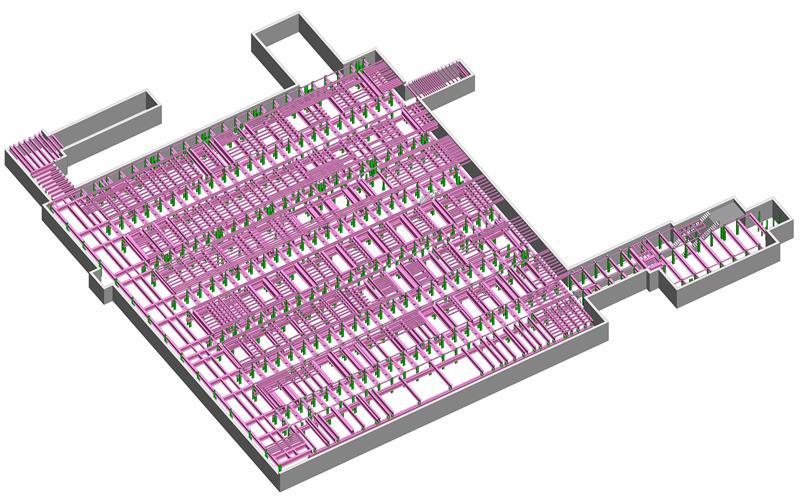
Construction projects face mounting pressure to deliver faster, cheaper, and with fewer errors. Traditional 2D blueprints and disconnected workflows create costly delays and coordination nightmares. Structural BIM modeling services offer a powerful solution that transforms how construction teams plan, execute, and deliver projects.
Building Information Modeling (BIM) creates intelligent 3D models that contain rich data about every structural component. Unlike basic CAD drawings, these models serve as a central hub where architects, engineers, and contractors collaborate in real-time. The result? Projects that run smoother, finish on time, and stay within budget.
The construction industry has embraced this technology rapidly. According to industry reports, BIM adoption has grown significantly across major markets, with many large-scale projects now requiring BIM deliverables as standard practice.
Enhanced Collaboration and Communication
Structural BIM modeling services break down the traditional silos that plague construction projects. Instead of working from separate drawings that may not align, all stakeholders access the same intelligent 3D model.
This shared digital environment eliminates the guesswork. When a structural engineer modifies a beam placement, the architect immediately sees how it affects the overall design. Mechanical engineers can identify conflicts with their ductwork before breaking ground. Contractors understand exactly what needs to be built and when.
The visual nature of BIM models makes complex structural concepts easier to grasp. Clients can walk through virtual buildings and understand design decisions that would be unclear on traditional blueprints. Project meetings become more productive when everyone literally sees the same picture.
Cloud-based BIM platforms enable remote collaboration, allowing global teams to contribute expertise regardless of location. This accessibility has become increasingly valuable as construction projects involve specialists from multiple geographic regions.
Improved Accuracy and Reduced Errors
Human error costs construction projects millions of dollars annually. Structural BIM modeling services dramatically reduce these costly mistakes through intelligent modeling and automated clash detection.
The software automatically identifies conflicts between structural elements and other building systems. A steel beam that intersects with an HVAC duct gets flagged immediately, not after installation begins. These clash detection capabilities catch problems during the design phase when changes cost hundreds rather than thousands of dollars.
BIM models maintain consistency across all project documentation. When structural specifications change in the model, all associated drawings, schedules, and quantities update automatically. This eliminates the manual coordination errors that plague traditional workflows.
The parametric nature of BIM modeling ensures that structural connections and relationships remain intact as designs evolve. If a column moves, connected beams adjust accordingly. This intelligent behavior prevents the dimensional errors that often surface during construction.
Quality control becomes more systematic with BIM. Project teams can run automated checks against building codes and design standards, catching compliance issues before they become field problems.
Streamlined Project Management
Structural BIM modeling services provide project managers with unprecedented visibility into construction schedules and sequences. 4D BIM links the structural model to project timelines, creating visual schedules that clearly show what gets built when.
This time-based modeling helps optimize construction sequences. Project managers can identify bottlenecks where structural work might delay other trades. They can also plan material deliveries more precisely, reducing storage costs and site congestion.
Resource scheduling becomes more accurate when based on detailed structural models. Instead of estimating labor hours from 2D drawings, project managers can extract precise quantities and complexities from the BIM model. This data supports more realistic scheduling and budgeting.
Change management improves dramatically with centralized BIM models. When design changes occur, project managers can quickly assess impacts on schedule, budget, and other building systems. Stakeholders see change implications immediately rather than discovering them during construction.
Progress tracking becomes visual and intuitive. Construction teams can update the model to reflect actual installation progress, providing real-time project status for all stakeholders.
Optimized Resource Allocation
Structural BIM modeling services enable precise quantity takeoffs and material planning. The intelligent model contains detailed information about every structural component, from the number of bolts in a connection to the exact length of each rebar segment.
This accuracy transforms material procurement. Purchasing teams order exactly what the project requires, reducing waste and avoiding costly rush orders for missing materials. Fabricators receive detailed information that streamlines production and reduces shop drawing cycles.
Labor allocation becomes more strategic when based on BIM data. Project managers can identify which structural elements require specialized crews and plan accordingly. Complex connections that need certified welders get scheduled appropriately, while standard framing can utilize general crews.
Equipment needs become clearer through BIM visualization. Crane requirements, lift sequences, and access routes can be planned in the virtual environment before mobilization. This advance planning prevents costly equipment conflicts and delays.
Budget tracking improves with BIM-based cost modeling. Project teams can link costs to specific structural elements and track spending with greater precision. This granular cost control helps prevent budget overruns.
Better Risk Mitigation
Construction projects face numerous risks that structural BIM modeling services help identify and mitigate early. The comprehensive nature of BIM models reveals potential problems before they impact project delivery.
Safety planning benefits significantly from 3D structural models. Safety managers can identify hazardous construction sequences and plan protective measures accordingly. Fall protection systems, temporary bracing, and crane operations can be designed in the virtual environment.
Structural analysis integration allows engineers to validate designs more thoroughly. Advanced analysis tools can work directly with BIM models, enabling more comprehensive structural evaluations. This integration catches design issues that might not surface with traditional analysis methods.
Constructability reviews become more effective with detailed structural models. Experienced builders can examine the virtual structure and identify installation challenges before mobilization. This advance review prevents field delays and costly design modifications.
Weather and environmental risks can be better understood through BIM-based simulation. Project teams can model how structural elements perform under various conditions and plan accordingly.
Quality assurance improves through BIM-based inspection planning. Inspectors can use the model to understand what needs verification at each construction stage, ensuring nothing gets overlooked.
Building the Future with Structural BIM
Structural BIM modeling services represent more than just a technological upgrade—they fundamentally change how construction projects succeed. The five benefits outlined here work together synergistically, creating project environments where collaboration thrives, errors diminish, and outcomes improve.
The construction industry continues evolving toward more integrated, data-driven approaches. Organizations that embrace structural BIM modeling services position themselves for long-term success in an increasingly competitive market. The question isn’t whether to adopt BIM, but how quickly your projects can benefit from its transformative capabilities.
Smart construction teams are already leveraging these advantages to deliver better buildings faster and more efficiently. The projects that consistently meet deadlines, stay within budget, and exceed quality expectations typically have one thing in common: they harness the power of structural BIM modeling services from project inception through completion.





